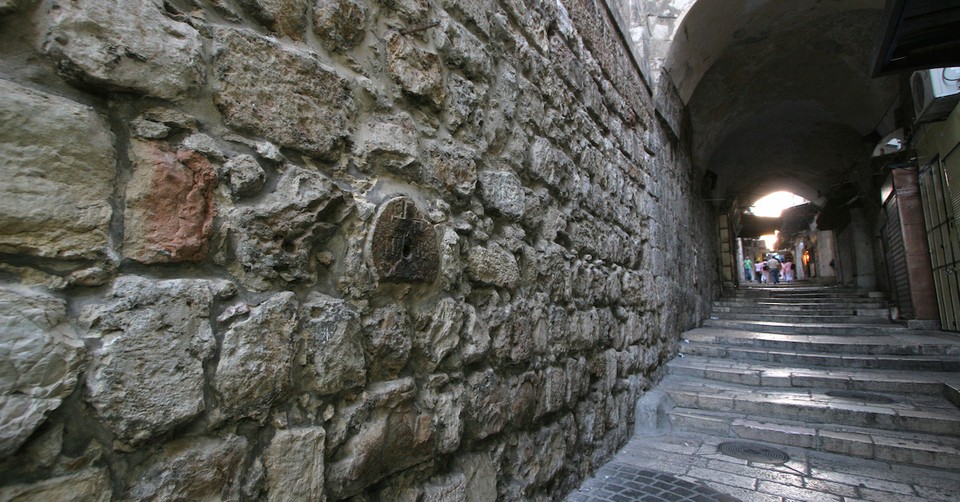Is the Via Dolorosa Biblical?

Depending on your church background, you may or may not have heard of the Via Dolorosa. It’s been part of Christian pilgrimages for centuries and plays a big part in discussions about Stations of the Cross as well as Christian traditions about where Jesus went in Jerusalem during the Passion Week. Here are the basic facts about the Via Dolorosa, along with a little background into its history.
What Is the Via Dolorosa?
The Via Dolorosa (sometimes called “the Way of Suffering) is a route located in the Old City of Jerusalem which follows the route that Jesus is believed to have walked on his way to be crucified. The route follows the traditional 14 Stations of the Cross, beginning with a place where Christians have traditionally believed Pilate condemned Jesus to death (the Lion’s Gate near what used to be a Roman fortress), and ending at a spot which is believed to hold the tomb where Jesus was buried (the Church of the Holy Sepulchre). The last location, the Church of the Holy Sepulchre, is a large building containing multiple chapels and levels and contains the last five stations (located in different areas).
The first historical reference we have of the Via Dolorosa is from the medieval period. Over the years, different Christians have suggested alternate sites for some of the 14 spots on the route, in the same way that some Christians have suggested alternate steps in the Stations of the Cross. The Via Dolorosa route that most people follow today was established in the 1800s, with some stations not put in their current spots until the 1900s.
Get your FREE Holy Week Guide here. Have encouragement delivered straight to your inbox!
What Are the 14 Stations of the Cross?
If you grew up Roman Catholic or in a “high church” Protestant background (such as Anglican or Lutheran), you probably grew up hearing about the Stations of the Cross a lot. If you come from a “low church” Protestant or nondenominational background, you may only know about these stations from friends or from films like The Passion of the Christ.
The Stations of the Cross are 14 scenes that describe what happened to Jesus in the last few hours of his life. The scenes vary a little bit in different traditions, but the standard stations are as follows:
Jesus is condemned to death.
The cross is laid on Jesus for him to carry.
Jesus falls over while carrying the cross.
Jesus meets his mother, Mary.
Simon of Cyrene is ordered to help Jesus carry the cross.
A woman named Veronica wipes Christ’s face.
Jesus falls a second time.
The women of Jerusalem weep over Jesus.
Jesus falls a third time.
Jesus reaches the crucifixion site and is stripped of His clothes.
Jesus is nailed to the cross.
Jesus dies on the cross.
Jesus’ body is removed from the cross.
Jesus is laid in the tomb.
Eight of these stations are directly based on the Biblical accounts, and are mentioned in the Gospels:
Jesus was given the death sentence of crucifixion (Matthew 27:26) (Mark 15:15) (Luke 23:23-25) (John 19:16).
Simon of Cyrene was made to help carry the cross (Matthew 27:32) (Mark 15:21) (Luke 23:36).
Righteous women wailed and wept as they followed Jesus carrying the cross (Luke 23:27–31).
Jesus’ clothes were taken off when he was crucified (Matthew 27:35) (Mark 15:24) (Luke 23:34) (John 19:23-24).
Jesus was nailed to the cross (Matthew 27:33-36) (Mark 15:24) (Luke 23:33) (John 19:18).
Jesus died on the cross (Matthew 27:45-55) (Mark 15:33-39) (Luke 23:44-49) (John 19:28-30).
Jesus was taken off the cross the same day (Matthew 27:57-58) (Mark 15:42-45) (Luke 23:52-54) (John 19:31-37).
Jesus was buried in a tomb donated by Joseph of Arimathea (Matthew 27:57-60) (Mark 15:42-46) (Luke 23:50-56) (John 19:38-42).
Other elements are from later Christian accounts. For example, Veronica (or Saint Veronica in Roman Catholicism) is mentioned in apocryphal Christian books like Acts of Pilate (also known as the Gospel of Nicodemus), which was written 300-500 years after the original Gospels. These sources describe Veronica as being a woman in Jerusalem who took pity on Jesus and wiped his face, and possibly also the woman who was cured of internal bleeding by touching Jesus’ clothing. Some Christian traditions from the medieval period claim the veil which Veronica used to wipe Jesus’ face had Jesus’ face imprinted on it (not unlike the Shroud of Turin). Today, there are at least six relics held at different Christian sites (including the Vatican) which are purported to be Veronica’s veil.
Can Christians Visit it Today?
As noted earlier, the modern Via Dolorosa was established between the 1800s and 1900s. It is still possible to walk this route in Jerusalem, although for obvious reasons the surroundings are different due to modern buildings being added in the area and the fact there are Islamic religious buildings and sites in Jerusalem as well. Despite the many changes over the centuries, the Via Dolorosa is very popular both as a tourist attraction and as a pilgrimage route, not unlike the routes that people will travel to see traditional sites of Jesus’ ministry (where he might have met the woman at the well, where he was born in Bethlehem, and so forth). You can find a variety of tours to take along the route, from free tours to ones organized through churches.
Did Jesus Actually Walk the Via Dolorosa on Good Friday?
Like many Christian pilgrimage sites in Israel, the Via Dolorosa is based on Christian traditions. Often, these traditions didn’t develop until years or even centuries after the fact. In the case of the Via Dolorosa, not only has the current route been debated and changed over the years, it’s still being debated as archeological discoveries bring new details about the period (such as a new site for where Pilate held Jesus’ trial). These discussions frequently lead to discussions about altering the Via Dolorosa even more. So, there’s a chance that Jesus walked the modern Via Dolorosa, but we aren’t completely sure.
When it comes to traditional Christian sites, we have to be cautious about claiming they are historically accurate but recognize there’s a chance they may be what they claim to be. We can also rest easy knowing that even if traditional sites aren’t historically accurate, the Gospels themselves have been shown to be historically accurate over and over again. This means we can still use sites like the Via Dolorosa as opportunities to think about what we do know about Jesus.
Christian writer Malcolm Muggeridge captured this humility about tradition mixed with awe at the facts in his 1968 sermon “Another King.” He talked about traveling to Israel to make a TV movie about the New Testament:
“It involved, along with much else, standing on what purports to be and, unlike most shrines, may well be the Hill of the Beatitudes where the most momentous of all sermons was preached some two thousand years ago. It was rather marvelous standing there looking down on the Sea of Galilee and trying to reconstruct the scene…”
- Vintage Muggeridge, pg. 21
Muggeridge admits he can’t say if the site is genuine, but he knows enough to say that the Sermon on the Mount did happen. As a result, visiting the site became a way to think about the Gospel story.
We can’t be absolutely certain that the Via Dolorosa is exactly where Jesus walked. We do know that Jesus did walk through Jerusalem. We know that he was tried, crucified, died, and rose again. If nothing else, sites like the Via Dolorosa provide opportunities to ponder those truths.
Photo credit: ©GettyImages/ZvonimirAtleti

This article is part of our larger Holy Week and Easter resource library centered around the events leading up to the death and resurrection of Jesus Christ. We hope these articles help you understand the meaning and story behind important Christian holidays and dates and encourage you as you take time to reflect on all that God has done for us through his son Jesus Christ!
What is Lent? It's Meaning and Why We Celebrate
When is Lent? When Does Lent Start and End?
What is the Meaning Ash Wednesday?
What is Holy Week?
What Is the Meaning of Palm Sunday?
What is the Meaning of Holy Monday?
What is Maundy Thursday?
What Is Good Friday and Why is it Good?
Good Friday Prayer
What Does Holy Saturday Mean?
What Is the Easter?
Easter Prayers
Powerful Facts About the Cross of Jesus
Originally published March 22, 2021.







